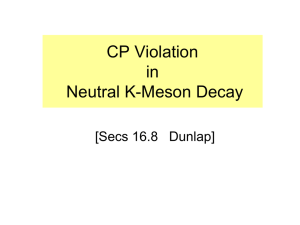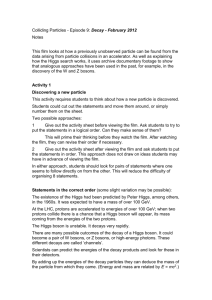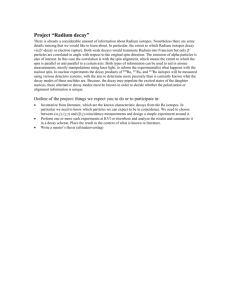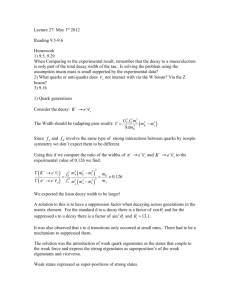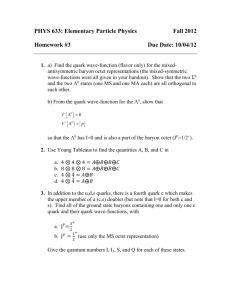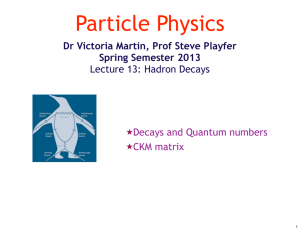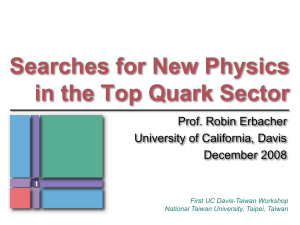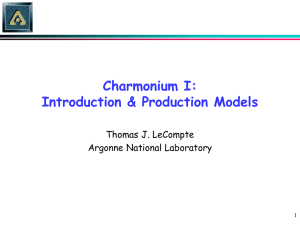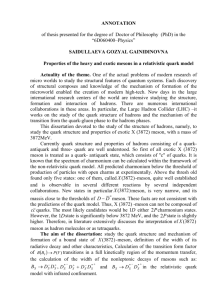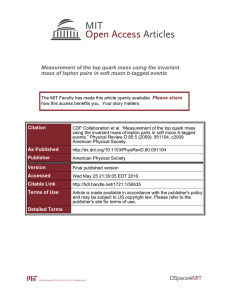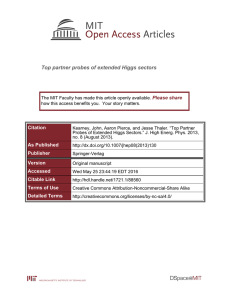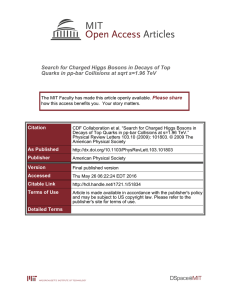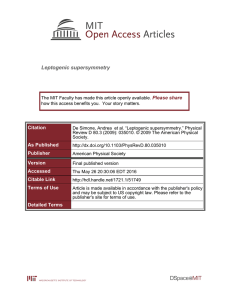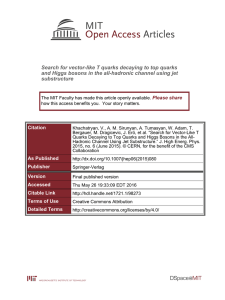Question Sheet with Solutions - University of Manchester
advertisement
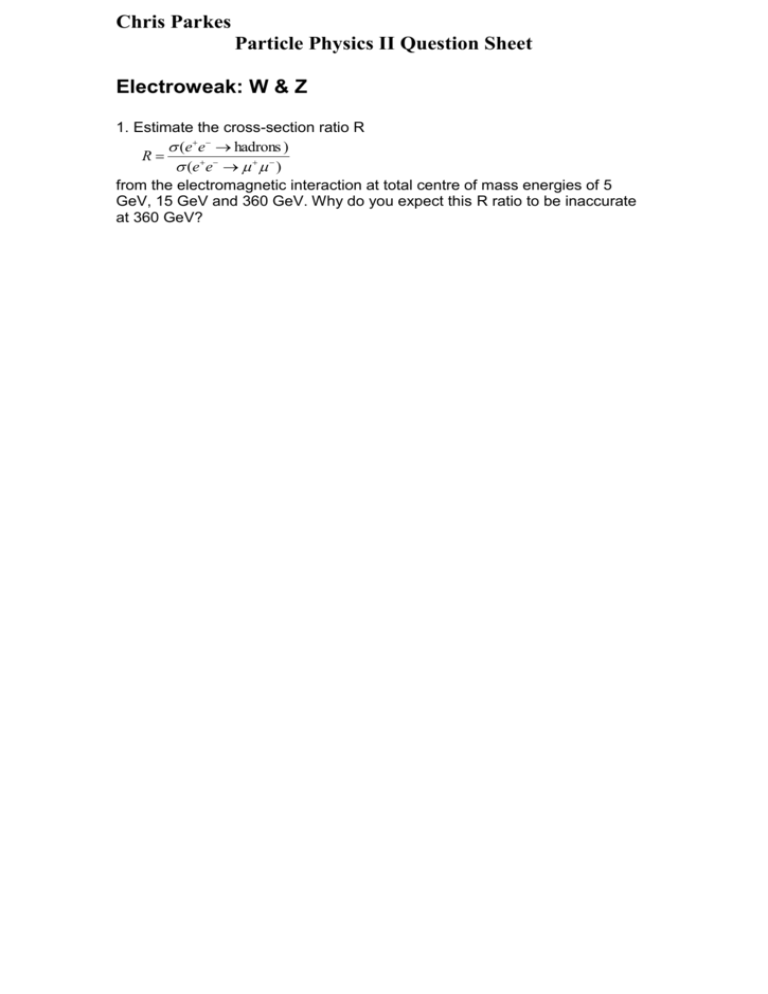
Chris Parkes Particle Physics II Question Sheet Electroweak: W & Z 1. Estimate the cross-section ratio R (e e hadrons ) R (e e ) from the electromagnetic interaction at total centre of mass energies of 5 GeV, 15 GeV and 360 GeV. Why do you expect this R ratio to be inaccurate at 360 GeV? 2. Use quark flow diagrams and the Weak and Electromagnetic decay vertices to determine which of the following interactions are allowed via the exchange of a single W or Z: (a) K 0e e (b) K e e (c) 0 0 e e (d) 0 n e e Which is allowed at “second order”: via exchange of two weak vector bosons? 3. [Extract from 2006 exam question] (a) What are the decay modes of the Z? (b) Estimate the branching ratios of the Z into hadrons and leptons. (c) The cross-section for the production of the Z in electron positron collisions is given by: 2 12M Z ( Z e e )( Z X ) (e e X ) 2 2 2 2 2 ECM ( ECM M Z ) M Z Z Sketch the cross-section as a function of centre of mass energy around the Z mass, and briefly describe how each of: MZ,ΓZ,Γ(Z→X) can be determined. (d) How can this be used to determine the number of neutrino types ? (e) Which important assumption is made in interpreting this as the number of neutrino types? 0 Top & Higgs 4. Draw an example Feynman diagram showing the production of a pair of top quarks from a quark anti-quark collision and their subsequent decays to final state particles. Explain which final states will be the clearest to observe above background events in a proton-proton collider. Solution Electrons/Muons give clear signatures in the event (particularly muons as they make it to last layer of the detector) and give a separation from fully-hadronic background. However, the hadronic W decays have a higher branching ratio, so a larger signal. The events can then also be separated from the main background by the high number of jets. The other important component is the ability to tag the decays into jets containing b-quarks using the flight distance of the b. Hence a good compromise channel for observing the decay is two tagged b jets + one more jet + an electron or muon. The main background is W to electron or muon + three jets from quarks/gluons. 5. Identify the dominant decay mode of a Higgs boson of mass MH=MZ, and estimate its branching ratios into lepton pairs. Solution Higgs couples to mass and hence will decay into heaviest available state, so into b anti-b pair. Rate is proportional to mf2, where f is the mass of the fermion, with an extra factor of three for the quarks for the colours. 2 2 Hence ( H l l ) : ( H bb) ml : 3mb Or since the b decay dominates the branching ratio is (H l l ) B ml 2 /3mb 2 (H bb) ml 0.5, 106, 1776 MeV, for electrons, muons, taus respectively. mb 4190 MeV, B 5 10 9 ,2 10 4 ,5 10 2 In the massless neutrino approximation there is no rate to neutrinos. 6. [Based on a 2006 exam question] a) Sketch a Feynman diagram of the process through which the Higgs boson could be produced at LEP. This is known as ‘Higgsstrahlung’. Explain why this process is not the direct coupling of the electron and positron to a Higgs. (b) Calculate the maximum Higgs mass that LEP was sensitive to, given that the LEP maximum beam energy was 103.5 GeV. c) Using your results in questions 3 and 5, explain in what final state modes the ‘Higgsstrahlung’ decay would have been searched for at LEP, and estimate their relative branching ratios. Describe briefly how each final state would have appeared in event display pictures from the tracking systems of the detectors. Solution a) Not direct coupling of Higgs to electron, positron, as Higgs couples to mass and the electron is light. Heavy Flavour Physics 7. Show how a leptonic decay of the virtual W in the b c transition indicates the flavour of the b quark. Show that the leptonic decay of the virtual W in the c s transition can result in a misidentification of the b quark as an anti-b quark or that if a c quark is produced and decays, it can cause a mistag. 8. Draw quark flow diagrams to determine if each of the following decays is Cabbibo-allowed, Cabbibo-suppressed, or forbidden in lowest order weak interactions: (a) D K e e (b) D K e e (c) D ee (d) D e e Mixing and CP Violation 9. Draw Feynman diagrams to show that D0 D0 mixing can occur in analogy to K 0 K 0 mixing. Comment on the relative sizes of the contributions of the different D0 D0 mixing diagrams by examining the CKM matrix elements. 10. Draw quark flow diagrams and show how to get a D , D and J / K s0 decay channel for both Bd0 and Bd0 mesons. In which case(s) must Bd0 Bd0 mixing be used? 11. [Slightly modified 2008 Exam question] (a) Quantum mechanical systems with N states where N is a small number have many applications in particle physics. Consider N = 2 which describes a two state system. In this system, let the eigenstates of operator O be labelled by their eigenvalues sa and sb as sa and sb . Let the eigenstates of another operator R be s1 and s2 . The relation of one set of states to the other can be described by a transformation matrix M. Explain why sa can be written in the form sa c1 s1 c2 s2 where c1 and c2 are constants. Describe the relationship the constants must have and show that this can be written in terms of a function of one parameter ,θ, so that sa cos s1 sin s2 . What is θ called? (b) Using the properties of the eigenstates, determine an expression for sb . Write the relationship of the state labelled by sa and sb in a matrix equation with the matrix acting on s1 and s2. Comment on the physical interpretation. (c) Determine the expressions for s1 and s2 in terms of sa and sb . (d) Apply the result to the down and strange quark mass eigenstates and the weak decay eigenstates, relating the matrix equation derived above to the physical quantities and comment on their values and meanings. (e) The C operator changes a quark into an antiquark and the P operator changes the parity of the system. Given that the parity of a K 0 and of a K 0 is negative, show the action of these operators and of the product of the operators, CP, on each of these particles. Indicate if the mass eigenstates of the neutral kaon are C and P eigenstates. Form an eigenstate for the CP operator from the neutral kaon system and determine the value of θ. f) Assuming that CP is violated by an amount ε, give an expression for the physically observed Kaon states K s0 and K L0 in terms of the CP eigenstates. K S0 K L0 1 1 2 1 1 2 K 0 1 K 0 1 K 20 K 20 Neutrino oscillations and other Beyond Standard Model 12. By drawing the lowest order Feynman diagrams, show whether charged or neutral current interactions or both can contribute to the following processes: a) X d u e b) X d d X c) X e X e where X is any of e , , . 13. Following the supernova explosion 1987A at a distance 1.5 x 10 21 m, a burst of e interactions was observed in a terrestrial detector. The interactions occurred over a time interval of 7s and the antineutrinos had a range of energies between 7MeV and 11MeV. Estimate an upper limit on the e mass. 14. WIMPs could potentially be discovered through their direct production at the LHC, or in experiments searching for interactions between a fixed field of WIMPS in our galaxy and detectors. a) Explain what the signature for production of a dark matter particle might look like in an experiment at the LHC. b) The sun moves in the galactic plane with a velocity of 2x105 ms-1. The Earth moves round the sun with a velocity of 3x104ms-1 in an orbit inclined by 600 to the galactic plane. How would the signature in the detector vary ? a) LHC could produce a pair of supersymmetric particles. A suitable candidate for WIMPS would be the lightest supersymmetric particles. The higher mass susy particles would decay into the WIMPs giving jets and leptons in the detector. The lightest susy particles/WIMPS would not be detected and would show up as missing transverse energy. b) The flux, and hence rate of interactions, would vary as the velocity of the Earth relative to the galactic WIMPs changes. So 2 v 2 105 3 104 cos 600 sin( (t to )) , where T is one year. Hence the annual T 3 104 0.5 7.5% . variation in signal is 2 105


